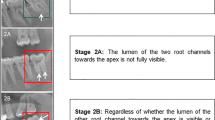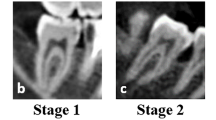Abstract
Purpose
The aim of this work was to determine the usefulness of the visibility of the dental pulp in lower third molars in forensic age estimation.
Methods
Dental pulp visibility on lower third molars was assessed using a sample of 487 orthopantomograms. Intra and inter-observer agreement was determined using the Cohen’s kappa test. A descriptive analysis of the stages according to age was done. The relationship between age and stage attainment was assessed using Chi square test and the strength and direction of the linear relationship between pulp visualization stage and chronological age was evaluated using Spearman rank order correlation (rho). Equations for predicting an age above 21 years were developed using logistic regression. The level of significance was defined at p < 0.05.
Results
The relationship between age and stage attainment had statistical significance for both sexes (p < 0.001). There was a medium positive correlation between the two variables for both genders (Spearman ρ = 0.420, p < 0.001 and Spearman ρ = 0.454, p < 0.001, for males and females respectively). The model built for age estimation successfully predicted age over 21 in 96.2 % of the females and in 96.9 % of the males. However, only 19.6 and 27.0 % of predictions were accurate for the group that was younger than 21, for females and males, respectively.
Conclusions
The accuracy of predictions for the group younger than 21 years of age was low, meaning that this methodology may not be suitable for age estimation. Still, stage 3 alone proved to be a suitable age marker for determining an age over 21 years.

Similar content being viewed by others
References
Karaarslan K, Karaarslan ES, Ozesevik AS, Ertas E. Age estimation for dental patients using orthopantographs. Eur J Dent. 2010;4:389–94.
Olze A, Bilang D, Schmidt S, Wernecke KD, Geserick G, Schmeling A. Validation of common classification systems for assessing the mineralization of third molars. Int J Legal Med. 2005;119:22–6.
Olze A, Solheim T, Schulz R, Kupfer M, Pfeifer H, Schmeling A. Assessment of the radiographic visibility of the periodontal ligament in the lower third molars for the purpose of forensic age estimation in living individuals. Int J Legal Med. 2010;124:445–8.
Schmeling A, Grundmann C, Fuhrmann A, Kaatsch HJ, Knell B, Ramsthaler F, et al. Criteria for age estimation in living individuals. Int J Legal Med. 2008;122(6):457–60.
Schmeling A, Reisinger W, Geserick G, Olze A. The current state of forensic age estimation of live subjects for purpose of criminal prosecution. Forensic Sci Med Pathol. 2005;1(4):465–9.
Knell B, Ruhstaller P, Schmeling A. Dental age diagnostics by means of radiographical evaluation of the growth stages of lower wisdom teeth. Int J Legal Med. 2009;123(6):465–9.
Schmeling A, Schulz R, Reisinger W, Mühler M, Wernecke KD, Geserick G. Studies on the time frame for ossification of the medial clavicular epiphyseal cartilage in conventional radiography. Int J Legal Med. 2004;118:5–8.
Garamendi PM, Landa MI, Botella MC, Alemán I. Forensic age estimation on digital X-ray images: medial epiphyses of the clavicle and first rib ossification in relation to chronological age. J Forensic Sci. 2011;56(1):S3–12.
Kellinghaus M, Schulz R, Vieth V, Schmidt S, Schmeling A. Forensic age estimation in living subjects based on the ossification status of the medial clavicular epiphhysis as revealed by thin-slice multidetector computed tomography. Int J Legal Med. 2010;124:149–54.
Garamendi PM, Landa MI, Ballesteros J, Solano MA. Reliability of the methods applied to assess age minority in living subjects around 18 years old. A survey on a Moroccan origin population. Forensic Sci Int. 2005;154(1):3–12.
Caldas IM, Júlio P, Simões RJ, Matos E, Afonso A, Magalhães T. Chronological age estimation based on third molar development in a Portuguese population. Int J Legal Med. 2011;125(2):235–43.
Olze A, Peschke C, Schulz R, Schmeling A. Studies of the chronological course of wisdom tooth eruption in a German population. J Forensic Leg Med. 2008;15:426–9.
Orhan K, Ozer L, Orhan AI, Dogan S, Paksoy CS. Radiographic evaluation of third molar development in relation to chronological age among Turkish children and youth. Forensic Sci Int. 2007;165(1):46–51.
Prieto JL, Barberia E, Ortega R, Magana C. Evaluation of chronological age based on third molar development in the Spanish population. Int J Legal Med. 2005;119(6):349–54.
Zeng DL, Wu ZL, Cui MY. Chronological age estimation of third molar mineralization of Han in southern China. Int J Legal Med. 2010;124(2):119–23.
Olze A, Pynn BR, Kraul V, Schulz R, Heinecke A, Pfeiffer H, et al. Studies on the chronology of third molar mineralization in first Nations people of Canada. Int J Legal Med. 2010;124(5):433–7.
Sequeira CD, Teixeira A, Caldas IM, Afonso A, Perez-Mongiovi D. Age estimation using the radiographic visibility of the periodontal ligament in lower third molars in a Portuguese population. J Clin Exp Dent. 2014;6(5):e546–50.
Olze A, Solheim T, Schulz R, Kupfer M, Schmeling A. Evaluation of the radiographic visibility of the root pulp in the lower third molars for the purpose of forensic age estimation in living individuals. Int J Legal Med. 2010;124(3):183–6.
Caldas IM, Carneiro JL, Teixeira A, Matos E, Afonso A, Magalhães T. Chronological course of third molar eruption in a Portuguese population. Int J Legal Med. 2012;126:107–12.
Schulz R, Muhler M, Reisinger W, Schmidt S, Schmeling A. Radiographic staging of ossification of the medial clavicular epiphysis. Int J Legal Med. 2008;122(1):55–8.
Schmeling A, Reisinger W, Loreck D, Vendura K, Markus W, Geserick G. Effects of ethnicity on skeletal maturation: consequences for forensic age estimations. Int J Legal Med. 2000;113(5):253–8.
Cohen JW. Statistical power analysis for the behavioral sciences. 2nd ed. Hillsdale, NJ: Lawrence Erlbaum Associates; 1989.
Author information
Authors and Affiliations
Corresponding author
Rights and permissions
About this article
Cite this article
Pérez-Mongiovi, D., Teixeira, A. & Caldas, I.M. The radiographic visibility of the root pulp of the third lower molar as an age marker. Forensic Sci Med Pathol 11, 339–344 (2015). https://doi.org/10.1007/s12024-015-9688-2
Accepted:
Published:
Issue Date:
DOI: https://doi.org/10.1007/s12024-015-9688-2




